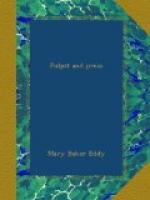At 7:30 a.m. the chimes in the great stone tower, which rises one hundred and twenty-six feet above the earth, rung out their message of “On earth peace, good will toward men.”
Old familiar hymns—“All hail the power of Jesus’ name,” and others such—were chimed until the hour for the dedication service had come.
At 9 a.m. the first congregation gathered. Before this service had closed the large vestry room and the spacious lobbies and the sidewalks around the church were all filled with a waiting multitude. At 10:30 o’clock another service began, and at noon still another. Then there was an intermission, and at 3 p.m. the service was repeated for the last time.
There was scarcely even a minor variation in the exercises at any one of these services. At 10:30 a.m., however, the scene was rendered particularly interesting by the presence of several hundred children in the central pews. These were the little contributors to the building fund, whose money was devoted to the “Mother’s Room,” a superb apartment intended for the sole use of Mrs. Eddy. These children are known in the church as the “Busy Bees,” and each of them wore a white satin badge with a golden beehive stamped upon it, and beneath the beehive the words, “Mother’s Room,” in gilt letters.
The pulpit end of the auditorium was rich with the adornment of flowers. On the wall of the choir gallery above the platform, where the organ is to be hereafter placed, a huge seven-pointed star was hung—a star of lilies resting on palms, with a centre of white immortelles, upon which in letters of red were the words: “Love-Children’s Offering—1894.”
In the choir and the steps of the platform were potted palms and ferns and Easter lilies. The desk was wreathed with ferns and pure white roses fastened with a broad ribbon bow. On its right was a large basket of white carnations resting on a mat of palms, and on its left a vase filled with beautiful pink roses.
Two combined choirs—that of First Church of Christ, Scientist, of New York, and the choir of the home church, numbering thirty-five singers in all—led the singing, under the direction, respectively, of Mr. Henry Lincoln Case and Miss Elsie Lincoln.
Judge S.J. Hanna, editor of The Christian Science Journal, presided over the exercises. On the platform with him were Messrs. Ira O. Knapp, Joseph Armstrong, Stephen A. Chase, and William B. Johnson, who compose the Board of Directors, and Mrs. Henrietta Clark Bemis, a distinguished elocutionist, and a native of Concord, New Hampshire.
The utmost simplicity marked the exercises. After an organ voluntary, the hymn, “Laus Deo, it is done!” written by Mrs. Eddy for the corner-stone laying last spring, was sung by the congregation. Selections from the Scriptures and from “Science and Health with Key to the Scriptures,” were read by Judge Hanna and Dr. Eddy.
A few minutes of silent prayer came next, followed by the recitation of the Lord’s Prayer, with its spiritual interpretation as given in the Christian Science textbook.




